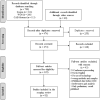Technology applications in bovine gait analysis: A scoping review
- PMID: 36696371
- PMCID: PMC9876379
- DOI: 10.1371/journal.pone.0266287
Technology applications in bovine gait analysis: A scoping review
Abstract
Quantitative bovine gait analysis using technology has evolved significantly over the last two decades. However, subjective methods of gait assessment using visual locomotion scoring remain the primary on-farm and experimental approach. The objective of this review is to map research trends in quantitative bovine gait analysis and to explore the technologies that have been utilized to measure biomechanical parameters of gait. A scoping literature review was conducted according to PRISMA guidelines. A search algorithm based on PICO framework generated three components-bovine, gait, and technology-to address our objectives. Three online databases were searched for original work published from January 2000 to June 2020. A two-step screening process was then conducted, starting with the review of article titles and abstracts based on inclusion criteria. A remaining 125 articles then underwent a full-text assessment, resulting in 82 final articles. Thematic analysis of research aims resulted in four major themes among the studies: gait/claw biomechanics, lameness detection, intervention/comparison, and system development. Of the 4 themes, lameness detection (55% of studies) was the most common reason for technology use. Within the literature identified three main technologies were used: force and pressure platforms (FPP), vision-based systems (VB), and accelerometers. FPP were the first and most popular technologies to evaluate bovine gait and were used in 58.5% of studies. They include force platforms, pressure mapping systems, and weight distribution platforms. The second most applied technology was VB (34.1% of studies), which predominately consists of video analysis and image processing systems. Accelerometers, another technological method to measure gait characteristics, were used in 14.6% of studies. In sum, the strong demand for automatic lameness detection influenced the path of development for quantitative gait analysis technologies. Among emergent technologies, deep learning and wearable sensors (e.g., accelerometers) appear to be the most promising options. However, although progress has been made, more research is needed to develop more accurate, practical, and user-friendly technologies.
Copyright: © 2023 Nejati et al. This is an open access article distributed under the terms of the Creative Commons Attribution License, which permits unrestricted use, distribution, and reproduction in any medium, provided the original author and source are credited.
Conflict of interest statement
The authors have declared that no competing interests exist.
Figures




References
-
- Whay HR, Main DCJ, Green LE, Webster AJF. Assessment of the welfare of dairy caftle using animal-based measurements: direct observations and investigation of farm records. Vet Rec. 2003;153(7):197–202. - PubMed
-
- Van Nuffel A, Zwertvaegher I, Pluym L, Van Weyenberg S, Thorup VM, Pastell M, et al.. Lameness Detection in Dairy Cows: Part 1. How to Distinguish between Non-Lame and Lame Cows Based on Differences in Locomotion or Behavior. Animals (Basel). 2015;5(3):838–60. doi: 10.3390/ani5030387 - DOI - PMC - PubMed
Publication types
MeSH terms
LinkOut - more resources
Full Text Sources

